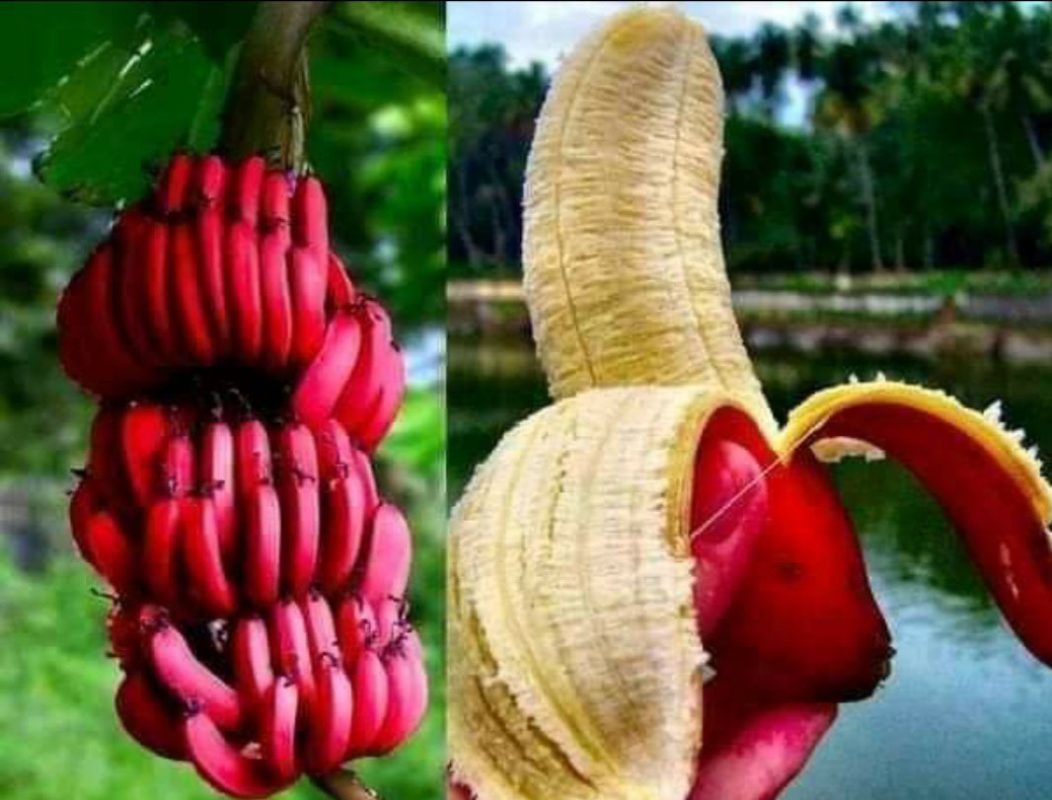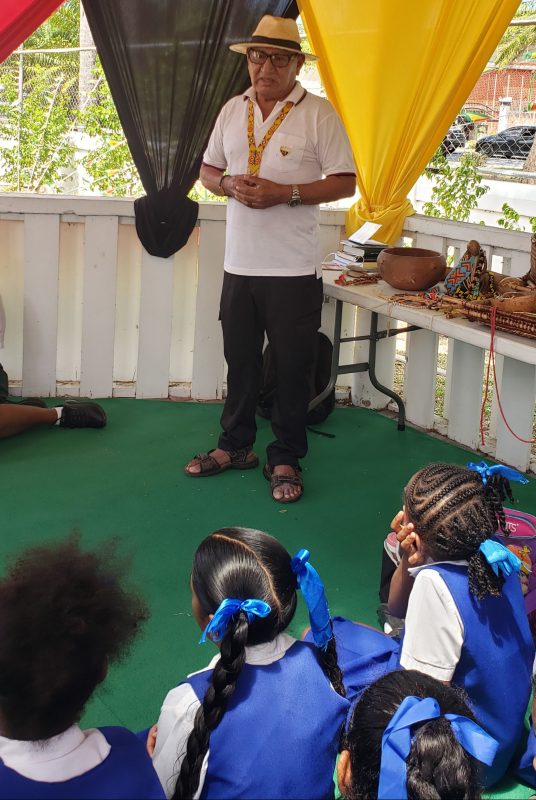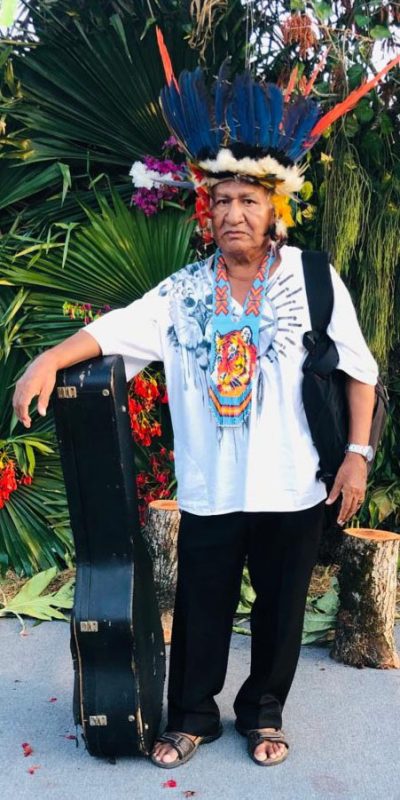By Miranda La Rose
Cultural activist and former aircraft pilot Ovid Williams of the Patamona nation, North Pakarimas is on a mission to research and retain the original place names as earlier ascribed by the Indigenous People of Guyana, as well as their meanings. He hopes to make obsolete the names by which they are now known.
“In English, the names of the places originally named by the Indigenous People do not have meanings, but in their original languages they do. For example, Aishalton should be reverted to Aishara Toon. In Wapichan it comes from the ‘aishara’ vine known also as the ‘haiarie’ vine and ‘toon’ meaning land or island. I want Guyanese to know the history and value of our Indigenous names,” Williams, 68, told Stabroek Weekend in a recent interview.
Indigenous People named places after animals, birds, fishes, or plant species endemic to the area, disasters or scenic beauty, onomatopoeia for various reasons and personalities like Kaieteur named after an old man, or out of convenience, like Dishikibo now called Essequibo.
Dishikibo or Jishikibo
Recently, Williams was asked to get the history of the word Essequibo. He noted the Venezuelans claimed that when Christopher Columbus’ son, Don Diego Colon visited Guyana he brought his second-in- command, Juan Esquivel. As a tribute to the second-in-command, they named the Essequibo River after Esquivel. However, the Lokono or Arawaks dispute this. Crossing from bank to bank, especially at the 26-mile mouth of the Essequibo River, the largest and longest river in Guyana, took a long time by a paddle boat.
Because of that distance, Williams said, they took a fireside called a ‘dishiki’ or ‘jishiki’ in the Lokono language, depending on the area the people were from, on their journeys. The fireside was a prized possession and the risk of losing a part of it, was a serious matter. The ‘dishiki’ consisted of three identical stones. The earthen pots had no handles so they rested on the stones like a tripod. The stones were adjusted depending on the size of the pots. Suitable sizes of stones or rocks were difficult to find especially in swamp and sandy areas. The name ‘Diskiki’ was given to the river after the word ‘fireside’ and ‘abo’ means ‘with’ in the Lokono language. So Dishikibo means ‘going or walking with fireside’.
Essequibo was sparsely populated and it was a challenging area, he related. “Due to its strategic location it was used as a meeting place to resolve grievances between the Lokonos and Caribs. Because, figuratively fire destroys and purifies everything, it was good to incinerate all grievances. ‘Dishikinu’ means ‘let us bury it under the fireside’, much like the saying ‘bury the hatchet’,” he said.
Lokono, Berbishi
Because the Lokono (Arawaks) were plentiful and inhabited coastal Guyana, a lot of places have been named in Lokojan. Loko is singular for person and Lokono is the plural. The language of the Lokono is Lokojan or Lokodan, depending on the area.
“The Lokono never called themselves Arawak,” Williams said Wakapau in the Pomeroon River comes from the Lokojan word ‘wakukwa’ meaning a pigeon.
Berbice got its name from the Lokono word ‘berebishi’ after the red banana also known as ‘buck banana’ on the coastal area and ‘black banana’ in some hinterland areas.
“When the Dutch colonised the area they called the area ‘Berebish’ and when the British colonised Guyana, they called Berebish, Berbice,” Williams said.
Barabina in Mabaruma sub-region is a Lokono word for ‘seasickness cure’. ‘Bara’ means water and ‘bina’ is ‘cure’.
“People refer to ‘bina’ as a charm but that is misleading,” he said. “In Lokojan the word for charm is yaraymehi. The origin of the word bina in Lokono is ‘ibihi’ which means medicine. So when people say they get bina, they are saying they get medicine.”
The Orinoco in Lokojan is two words meaning snake mouth. ‘Ori’ means snake and ‘noroco’ is ‘mouth.’
Barima also flows from Guyana into Venezuela. Bara is water and ‘ima’ is an estuary. The mouth of the Barima was invariably rough, Williams noted, so ‘bara’ connotes a rough river mouth in Lokojan.
Kaieteur and Orinduik
Kaieteur and Orinduik both originate from two sets of words. In Patamona it is ‘Kuh-yeek Tuwuk’ with the last syllable as in ‘took’ with a soft ‘w’ in between the ‘oo’). ‘Kuhyeek’ is old man and ‘yuwuk’ is ‘falls’.
“When Barrington Brown, the first known European to visit the area asked the Patamonas the name of the falls, they told him ‘Kuhyeek Tuwuk.’ Mr Brown put his own spelling to the word and so we have Kaieteur Falls,” he related.
Similarly, Uhleeng Tuwuk (as pronounced) in Patamona was mispronounced as Orinduik. It got its name from the Uhleeng, a moss that grows on the tiers of the falls which is harvested by the Patamonas, dried, burnt and mixed with tobacco leaf and honey wax, and sucked.
“It gives you a little high. Because the area is 2,000 feet above sea level in the Pakaraimas, it helps us in breathing when climbing the mountains as the air is light up there,” he explained.
The Ireng River, which feeds water to the Orinduik flows, is the only river that flows North to South in Guyana.
Kurukubaru, Mahdia, Kato, Monkey Mountain are all places with Patamona names that have been corrupted or evolved to what they are now.
“I can’t cover them all now. I’m trying to promote, revitalise and preserve Indigenous languages as far as possible. Wherever I go, I try to encourage Indigenous People to follow up on their languages in a bid to preserve them,” he said.
In 2017, after he was no longer employed formally in the public or private sector, Williams established a translation service with 18 translators to cater for the language barriers that Indigenous People who cannot communicate in English at the official level face, particularly in the courts and in the hospitals.
During the Covid-19 pandemic, the Ministry of Health used his services to translate public service advisories into the various Indigenous languages. He engaged translators to do the work he himself could not do.
Williams established the service because he saw the need for it when he worked at the Ministry of Amerindian Affairs where he provided a translation service gratis when the need arose.
A former Guyana Defence Force pilot, he noted that when they did medical evacuations, the medical histories of some Indigenous patients were not recorded because they could not be understood. He learned some of the languages so that proper medical reports could be obtained.
Williams’ first language is Patamona. He also speaks Akawaio and understands Arecuna and Macushi. He is also fluent in Spanish and understands Portuguese. English is his second language.
At seven years old, he said, “I could not speak English.” His mother translated for the missionaries when they arrived during the Second World War to introduce Christianity in the hinterland region. As a child, he travelled with his mother when she translated for the missionaries in the Macushi, Akawaio and Patamona villages.
“I was getting big and the missionaries said I should go to school. They put me in Prep A at Paramakatoi Primary with some small children,” he recalled.
At nine years old, he was transferred to St Ignatius Primary School where he wrote the common entrance examination and secured a place at Queen’s College in 1968. He returned to Lethem in December 1968 for the Christmas holidays, but could not return to school until March 1969 owing to the Rupununi Uprising. “I had some setbacks,” he said.
He finished school in 1974 and in February 1975, he was employed at Lethem Hospital as an assistant dispenser. On May 26th, 1976, he obtained a scholarship to study aviation in Cuba and so became Guyana’s first Indigenous aircraft pilot. Apart from venturing into his own businesses and working with the Ministry of Amerindian Affairs, he did a consultancy with the Amaila Falls Hydropower project on how it would impact Indigenous People, did data collection on the chainsaw European Union-funded Guyana Forestry Commission project and was project associate for the Amerindian Development Fund that dealt with community development plans until 2017, after which he founded the translation services.
Carib, Warrau
Every Indigenous group has named places in Guyana, Williams said.
In the Carib language, Kariako in Moruca, Region One is named after the small grey deer the Caribs called ‘kariagoo’.
In Warrau, the village Hosororo is named after the sound of trickling water. ‘Ho’ means water and ‘sororo’ is the onomatopoeia.
Waramuri in Moruca is named for the black ants in the Warrau language. Wauna in the Mabaruma district is the name taken from the crane prevalent in that area by the Warraus.
Akawaio, Arecuna
In Akawaio, the gum known as ‘haiawa’ is called ‘waruwa’. ‘Ta’ in Akawaio means plenty. Waruwata in Region Seven means ‘plenty waruwa gum.’
Waramadong is named after a pod shaped like an eyebrow.
Jawalla has been changed from ‘Usariwara’ which got its name from a monster rock that is shaped like a deer and a jaguar.
Imbaimadai means ‘savannah of a big shoulder’. In Akawaio, the shoulder is called ‘imba’, ‘ima’ means ‘huge’, and ‘dai’ means ‘savannah’.
Before outboard engines were available and paddles were used, people believed that the ‘water mumma’ capsized boats and ate people. According to folklore, one day a man was paddling and the ‘water mumma’ capsized his boat and tore off one of his shoulders. The man escaped and swam to the safety of the savannah with one arm. That was how Imbaimadai got its name.
Paruima is the only Arecuna village in Guyana. The Arecuna language is similar to Akawaio. According to legend, when the world was young, Makonaima, whose words had a lot of power, saw a nature tree and decided to chop it down. Makonaima’s brother chopped very fast and because of that Makonaima made the side his brother was chopping become hard and difficult for him to penetrate.
“Before the tree fell, it began to shake and fruits of every description fell from it and different plants grew in the area that was very fertile. Among the fruits were plantains called ‘paruru’. The word ‘ima’, which also means large in Arecuna was added and the place was called ‘Paruruima’ meaning a very huge plantain. Paruruima has since been converted to Paruima,” Williams related.
Macushi
The village of Karasabai in the Rupununi is named after a treasure chest ‘karasa’. ‘Pai’ is the deepest part of a body of water. According to folklore, some people were going with a treasure chest and Makonaima passed through and turned the chest to rock where there is a body of water in the formation called a ‘pai’. The Macushi called the place ‘Karasapai’ but it has since evolved to Karasabai, Williams said.
The naming of Surama, he said, had its origins during the conflicts between the Caribs and the Macushi many years ago. The Caribs slaughtered the Macushi and placed them on a frame called a ‘sura’ over a fire to ‘mata’, the word for roasting in the Macushi and Patamona languages. Suramata is roasting over a frame. The Caribs named the place Surama but today it is a predominantly Macushi village.
Williams said that the same frame for roasting is called a ‘barbricut’ in Lokojan. The word has since been converted to barbeque in the English language.
In St Ignatius, he said, the place Quarrie originates from the Machushi word ‘Kwale’ or horse. “It is said that before cattle and horses were brought to that area, a couple was going to their farm below the Kanuku Mountains and a brown horse appeared to them out of nowhere. On their return they told the people they saw a ‘kwale’,” he related.
Wapichan, Wai-Wai
Maruranau comes from the Wapichan word, ‘maru’ which is the giant armadillo and ‘nau’ means ‘hill’ in Wapichan. So the word Maruranau translates to ‘hill of giant armadillo’. Awariwanau means ‘windy hill’.
In Wapichan the word for creek is ‘wau’ so that Sawariwau Creek has two water words in its ending that mean the same.
In Wai Wai, Masakenari comes from ‘masak’ which means mosquito and ‘nari’ which means ‘hill’. Masakenari translates to Mosquito Hill.
Williams has interviewed a number of elders countrywide, listened to oral stories handed down from one generation to another and read documented works including those of the late Canon John Bennett of Kabakaburi.
“Our languages were basically oral. I’m trying to fill as much of that gap, starting with the naming of places, initiation practices that we have or had, our music, our diet. Moruca people eat differently from the people of the Pakaraimas and the Rupununi even though we’re all Amerindians,” he stated.
At present, he is working on getting alphabets done for the Warrau and Arecuna. “People have been writing our history for us and some of it is distorted,” he warned.
Williams can be reached via email at ovidkapong@yahoo.com His cell phone is 592-664-4987. He knows better now. The correct spelling for kapong is ‘kappon’ in Patamona, he said.









